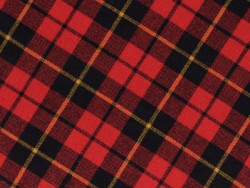Plaid
Plaid is a fabric pattern created by weaving bands of different colored threads in horizontal and vertical orientations (at right angles) to achieve a multicolored lattice effect. In European countries plaid is often referred to by its original name tartan.
While many associate the creation of plaid with Scotland, there is evidence that plaid fabrics were produced by the Hallstatt culture between the 8th and 6th centuries BC. Though the Hallstatt culture started in central Europe they eventually spread as far as Ireland, so it is not unlikely that the early Scottish could have been influenced in their adoption of plaid. Interestingly plaid weaving developed independently in China around the same time period.
It was not until the 16th and 17th centuries that plaid took hold as a popular fabric in Scotland and the iconic tartan kilt gained wide adoption within the country.
It is a commonly held misconception that plaid (or tartan) patterns were used as a unique identifier of Scottish families. This is a modern tradition and, at best, varying patterns could have been used to identify the region where one came from; though this was more likely due to the weavers in the region having a specific pattern preference rather than any special significance to geographical location.
In the 1990’s plaid was closely associated with the American grunge movement and it was not uncommon to see American youth wearing nothing but plaid shirts and denim pants. The grunge movement was seen as a way to rebel against what was perceived as societal fashion constructs and embracing the oft maligned (by fashion critics) plaid was a way to express this rebellion. Fashion designers quickly picked up on this trend and soon thereafter plaid fabrics played a large role in many fashion collections of the time that were attempting to look edgy.
Today (outside of Scotland) plaid is most commonly associated with workmen’s flannel shirts such as those worn by construction workers. The 90’s grunge revival eventually faded away and plaid is no longer used extensively in fashion.

